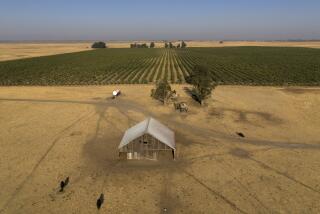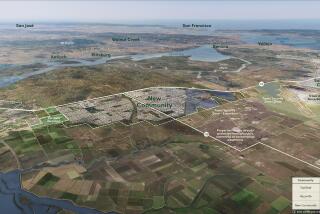Moorpark Planners Back Village Project
A $300-million lakeside development that would be built in the hills north of Moorpark College cleared a major hurdle this week as it advanced toward a public vote.
The Moorpark Planning Commission agreed Tuesday night to recommend City Council approval of the 1,650-home North Park Village development, which would include a 52-acre man-made lake, a 2,100-acre nature preserve and a 29-acre sports park. If approved by the council in June, it would probably go on the ballot next spring.
“Working with the applicant has been enjoyable and challenging at the same time as we try to come up with the best project for the city of Moorpark,” said David Lauletta, commission vice chairman.
But although the project includes plenty of amenities, Moorpark voters will have the ultimate say over whether it is ever built because it lies beyond the city’s growth boundaries. A 1998 voter-approved ordinance requires a public vote before any land can be annexed to the city for development.
After nine months of hearings and deliberations, the Planning Commission on Tuesday unanimously recommended approval of the environmental impact report on the project, forwarding more than 1,000 pages of documents to the City Council.
Kim John Kilkenny, a vice president of Village Development, told commissioners that more than 75% of the 3,586-acre site would remain undeveloped, more than 75% of the hillsides would be untouched and more than 82% of the property’s mature trees would be saved.
Kilkenny said he thought the project was significantly improved by the public’s input, particularly on traffic and water quality issues, over the last few months. “The plan is better today than it was when we presented it last summer. And I suspect it will get even better once the City Council has a chance to look at it,” he said.
The San Diego-based development company plans to secure a bond and deposit $50,000 for each of the first 500 homes constructed to guarantee that $25 million is available to build an offramp from California 118, a mile east of Collins Drive, to serve the college and the new homes.
The commission and the developer have already agreed upon numerous changes to the original plan, including extending a public trail so it loops around the entire lake, consolidating two smaller recreation areas into a nearly 10-acre lakeside park, doubling a proposed school site to 18 acres, adding a second wildlife crossing and leaving the design of the community park to recreation officials and residents.
The plan also calls for mixed uses near the lake, with residences built above shops in a 45,000-square-foot commercial development. The builder would also provide 150 affordable housing units.
“This developer has listened, been very cooperative and made a number of changes,” said Commissioner Kipp Landis, adding that someday he would like Moorpark to be considered a step above nearby Westlake Village, an upscale suburban city also built around a lake.
Before voting on the project, Commissioner Mark DiCecco spoke of the city’s obligation to provide its share of the region’s housing needs and for recent residents to accept that Moorpark, a city of 31,000, was still growing. “Much can be said about the social and environmental ills of urban sprawl,” he said, “but they are ills we have collectively created.”
He said the North Park Village project should continue to move through the process until voters get to decide whether they think the project would improve their quality of life and whether it was preferable to the possibility of as many as 89 exclusive ranches that could be built on the site without city approval.
“This project is not just about houses. It’s about ... a new school, community services, amenities, parks, a lake and a permanently accessible, pristine 2,100-acre nature preserve, all available to the entire population of Moorpark,” DiCecco said.
But commission Chairman Scott Pozza cautioned that if North Park Village is built, the region’s traffic problems will worsen. “We all accept growth, I just want it to be smart growth,” Pozza said, noting that he does not support expanding the city’s growth boundary to accommodate North Park Village. “Whether we support the project or not, it’s going to go to a vote of the people, and I think that’s exactly what should happen.”
Four of the seven residents who spoke Tuesday night were against the project, raising concerns about traffic, water quality, the possible spread of valley fever because of massive grading and the loss of Moorpark’s small-town atmosphere.
After the meeting, Kilkenny said public discussion of the project helped uncover the potential for groundwater contamination within the original site plan, which led to 33 residential lots being relocated. Expansion of the lakeside trail and enlarging the park near the waterfront were other ideas Kilkenny said improved the project’s design.
Despite spending more than $1 million so far on environmental analysis, Kilkenny said the company and its consultants would probably conduct more soil studies and assess the potential for new cases of valley fever. The respiratory disease is spread through an airborne fungus.
Mayor Patrick Hunter said the council would probably schedule several public hearings on the project’s environmental report. The first could be held by late May or early June.
Hunter said he expected further discussion on traffic, grading and the capping of several oil wells on the site. He also expressed concern about the safety of the proposed man-made lake and that its upkeep not become the responsibility of taxpayers.
“We’re talking about a 52-acre lake, and I want to make sure we proceed slowly and cautiously because this would be our first time trying to provide this sort of amenity in the community,” Hunter said. “My goal is to ensure that if the project is approved with the lake component, it does not become a burden to the city down the road.”
Councilwoman Roseann Mikos said she looked forward to thoroughly reviewing the details of the project. Among the issues Mikos said concerned her were traffic, groundwater quality, wildlife habitat, population growth and whether to allow yet another gated subdivision in Moorpark.
“I want to have a lively debate and I hope the public will stay involved,” she said. “I do believe it will be a lengthy discussion
Kilkenny said that the environmental issues have been identified and properly studied. If the project wins the council’s support and goes on the ballot, he expects it to have a much better reception than Hidden Creek Ranch, a proposal rejected by voters in 1998 that would have erected more than 3,200 homes on the same site.
“If the public fully understands the process we’ve gone through and what the project offers,” Kilkenny said, “I think we’ll do very well on election day.”
More to Read
Sign up for Essential California
The most important California stories and recommendations in your inbox every morning.
You may occasionally receive promotional content from the Los Angeles Times.










